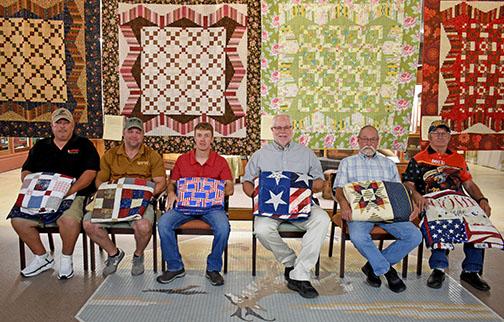Saturday event part of A’ROR’N Days celebration
Six Aurora veterans were honored with quilts of valor during this year’s A’RORN’N Days weekend.
Darcy Greenough, Tanner Greenough, Jarod Greenough, Jeffrey Muilenburg, Jimmie Lewis Smith, and John Tessman were all honored.
Darcy Greenough
Darcy Greenough joined the United States Marine Corps right out of high school in 1988. He attended boot camp in San Diego, and then went to school at Fort Lee, Virginia as a bulk fuel specialist.
He was then stationed in Okinawa, Japan with the 9th Engineer Support Battalion. After one year in Japan, he was deployed to the Philippines. There, he protected the Filipino president during a coup attempt.
After a year in the Philippines, Greenough came back to the states where he was stationed at Cherry Point, North Carolina. Shortly following, he was sent to Saudi Arabia to support the Desert Shield and Desert Storm operations.
After the gulf war, he went back to Cherry Point where he finished the rest of his time in the military. He then made his way back to Aurora.
Tanner Greenough
Tanner Greenough, one of Darcy Greenough’s sons, served in the Marine Corps from 2006 to 2010.
He was stationed at Camp Pendleton in California as an Infantry Rifleman.
In his first deployment, he was on a naval ship that made trips to the Middle East, Africa, Singapore, Bangladesh and Australia.
His second deployment sent him straight to Afghanistan. He was a part of Operation Khanjar, taking over an area in the Nawa District of the Helmand Province. They were the first Americans to take over this area from British troops.
Operation Khanjar was the largest helicopter assault mission since the Vietnam War.
Greenough was of the first 60 Marines to secure the area until 1500 more came later.
He was in Afghanistan for about a year. During this time they had eliminated the Taliban in their area.
When he had first arrived at Nawa, kids that were seven and eight years old had never been to school because of the Taliban’s rule in their area. By the time he left, those kids were able to go to school with smiles on their faces, he said.
Jarod Greenough
Jarod Greenough, Darcy Greenough’s son and Tanner Greenough’s younger brother, served four years in the Marine Corps starting in 2016.
He did his boot camp in San Diego, and then went to Camp Pendleton in California for school. After he was done, he was given orders to the same unit his brother was in a decade prior: Charlie Company of First Battalion, Fifth Marine Regiment.
Greenough was a fireteam leader and earned a secondary specialty as a range coach. He was also promoted to Lance Corporal.
He was deployed with the 15th Marine Expeditionary Unit, spending time in Singapore, Malaysia, Guam, Dubia, Djibouti, Bahrain and Israel.
After his return to the U.S., Greenough attended an advanced infantry course to become a squad leader.
Upon graduation, he was promoted to Corporal and received orders to Gulf Company of Second Battalion, First Marine Regiment until he was done with his enlistment.
Jeffrey Muilenburg
Jeffrey Muilenburg was born into the military. He was born in Fairbanks, Alaska where his father was stationed in the Army.
His childhood was spent moving every four years, including a period of time in Germany in his elementary years.
Muilenburg’s older brother attended West Point Military Academy in New York, and Muilenburg was set to do the same. He had also applied to the Air Force Academy in Colorado, which was his goal.
Muilenburg received an appointment at the Air Force Academy in Colorado in 1980. During his freshman year there, he got to participate in parade marching where they got the opportunity to march in President Ronald Reagan’s inaugural parade.
Muilenburg completed an engineering degree with a minor in biological sciences in May of 1984. Afterward, he was commissioned to serve in the U.S. Air Force at Brooks Air Force Base in San Antonio as second Lieutenant.
He was a bioenvironmental engineer working with the Occupation and Environment Health Laboratory (OEHL) analyzing soil, water and air samples from around the U.S. as a part of the Air Force Environmental Protection Agency.
During his third year of service Muilenburg applied to Kansas University’s medical program to pursue his goal of being a doctor.
KU held his acceptance for a year so he could finish his service.
Muilenburg received a service medal for his four years of service in the OEHL unit at Brooks Air Force base. He was honorably discharged in 1988.
Jimmie Smith
Jimmie Smith served in the U.S. Air Force from July 26, 1960 to July 26, 1966.
Smith received his basic training at Lackland Air Force Base in San Antonio. Then he was stationed at Chanute Air Force Base in Rantoul, Illinois. He was part of Aerial Squadron Detachment Number One.
It was here where Smith was trained as a parachute rigger where he learned to pack and repair parachutes.
Smith went to Naha Air Force Base in Okinawa, before it was claimed by Japan. He spent the next 19 months packing drag chutes, personnel chutes and cargo chutes.
He came back to the states and was stationed at Whiteman Air Force Base in Knob Noster, Mo.
The base was being changed into a missile base, so Smith moved to Lockbourne Air Force Base in Columbus, Ohio.
Smith was discharged in 1966 and held the rank of Airman Second Class E3.
John Tessman
John Tessman (better known as Doug) did his basic training at Lackland Air Force Base in San Antonio in 1966.
After basic training, he went to Sheppard Air Force Base to become a water treatment specialist.
Tessman’s first stop was Eielson Air Force Base in Alaska, where it was -30 degrees when he first arrived.
Tessman’s favorite part about being a water treatment specialist was taking care of swimming pools on base. He enjoyed it so much that he extended his time at Eielson.
Then, he was off to Charleston, South Carolina where he worked in the sanitation department–and got three swimming pools to take care of.
Tessman returned home in 1969.





